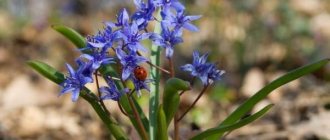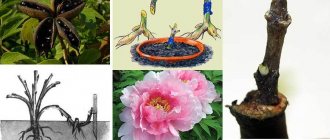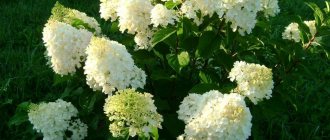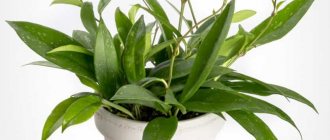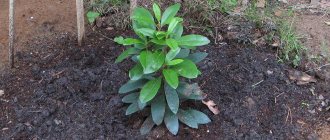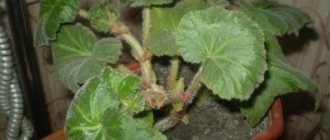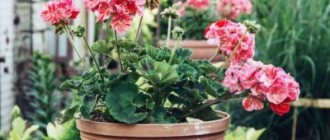Popular varieties
To achieve success when cultivating ferns in the garden, you need to choose the right type of plant.
Female Kochedyzhnik
This crop is characterized by dissected leaves that form bunches. Under natural conditions, it grows in swamps, forming hummocks. The size is determined by the crop variety and can reach 30-70 centimeters. The roots of the bush are short and thick.
Common bracken
This plant reaches 70 centimeters in height. It grows well in dry soil, which contains a small amount of useful substances. The culture is characterized by long horizontal leaves resembling eagle wings. The plant contains toxic substances, which is why it poses a danger to pets. Moreover, this type of fern is absolutely harmless for people.
Male shieldweed
Under natural conditions, the culture develops in the shade and reaches 0.3-1.5 meters. Pores resembling a shield accumulate on the underside of the leaves.
Common ostrich
This crop is distinguished by feathery leaves that resemble the openwork pattern of ostrich feathers. They can reach 1.5 meters in size. With the arrival of spring, the leaves become like a rolled cocoon. Then they bloom and resemble a luxurious cone. The vertical root system requires systematic loosening and mulching.
Asplenium
The culture is popularly called Kostenets. Most aspleniums need warmth. However, there are also frost-resistant crops that can withstand temperatures down to -18 degrees.
See also
Growing and caring for Schisandra chinensis, planting secrets
Nest-like asplenium
This plant is able to grow even without soil, since under natural conditions it takes root on leaves and trunks. The size of the culture reaches 1 meter. Its dwarf species are found in flower shops.
Bulbous asplenium
This is a deciduous fern native to New Zealand. It can be grown in the garden. In this case, it is recommended to cover the root system with dry leaves. You can also dig up the bush and keep it in the cellar until spring arrives. The length of the plant reaches 60 centimeters.
Fern in landscape design
Nature has created beauty that you want to admire again and again.
Ferns, with their mystical “character”, inspire designers to make the most daring decisions in landscape design. Fern in landscape design For example, the Marsilia four-leaved looks great on the water surface: it is planted directly into the water to a depth of 50-70 cm. The four-lobed openwork leaves of Marsilia beautifully edge the pond, giving it the charm of the ancient Paleozoic.
Marsilea quadrifolia
The fern will decorate the alpine hill, giving it a very mysterious look; will be appropriate in a rock garden, will create a beautiful carpet in the country, and an epiphytic fern will decorate the walls of a country house or sit comfortably on trellises.
How to choose and prepare a place
To achieve success in growing a crop, it is recommended to choose the right site for planting it.
Lighting
The culture develops normally in shady places. At the same time, a long absence of light negatively affects the condition of the leaves. They become yellow and dull. This does not harm the crop, but provokes a deterioration in its decorative properties.
The best option for ferns is diffused sunlight. It is advisable to avoid direct sunlight.
Soil requirements
Ferns require loose soil that absorbs moisture well. To avoid stagnation of moisture and the development of putrefactive processes in the roots, you will need river sand. The excavated soil should be mixed with peat and sand. It is recommended to maintain a ratio of 2:2:1.
How to get rid of bad consequences?
In order to avoid negative consequences from growing this plant at home, you should follow several rules:
- Place the plant away from people and closer to electrical appliances.
- Don't bring a flower from the forest. He should be where he grew up. The forest plant is surrounded by a mystical aura. Wild specimens have the most negative consequences.
- A large number of spores on the leaves of this plant can cause allergies in humans. If you or your family are prone to allergies, then you should not bring ferns into the house.
- If you can’t get along with the plant, then you need to part with it. Otherwise, you can harm your health.
Growing such a plant in the house is associated with a large number of signs. Whether to believe in them or not, everyone decides for himself.
Carefully study all the information about the fern before you bring it into your living space. Despite the fact that its habitat is forest, it takes root well at home.
Reproduction methods
There are many methods of fern propagation, each of which has certain characteristics.
Disputes and division
Reproduction by spores is considered a rather complex and painstaking method. To do this, you need to cut off the ripe spores with leaves in the fall, and place them in a special substrate in January. To prepare it, you should mix peat, leaf soil and sand in a ratio of 2:1:1.
It is recommended to place the spores on top and moisten them with a spray bottle. Cover the container with glass. You can expect sprouts to appear 2 months after planting.
When propagating varieties with long rhizomes, it is enough to cut the adult plant into 2 parts in early spring. If there is no risk of return frosts, the crop should be planted in the ground. In this way you can propagate bracken, ostrich and other plants.
Rhizomatous tendrils
This method is not used for all varieties of fern. Thus, the cordifolia neurolepis has mustaches, which are presented in the form of aerial processes. They can be buried in the ground and watered well. Thanks to this, it will be possible to obtain a new culture.
Brood buds
This method is considered the most labor-intensive and least productive. For planting, it is worth separating the top of the leaves and placing them in peat or moss. They should definitely be moisturized every day. When the buds take root, they can be transplanted to a permanent location.
Ready-made bushes
This is the simplest and most popular method. To do this, just find a suitable bush in the forest and dig it up. It is important to wrap the roots with soil so that they do not dry out during transportation. It is recommended to moisten the plant a little. At home, it should be divided and planted in a permanent plot.
See also
Rules for planting and caring for indoor hibiscus at home
Open ground planting scheme
Before planting, it is worth assessing the size of the plant. Taking this into account, prepare the hole. For large varieties, its diameter should be 50 centimeters and its depth should be at least 40. It is recommended to fill the hole with the same soil in which the bush grew before replanting. Thanks to this, he adapts much more easily.
If the finished plant was purchased from a nursery, you should add peat when planting it in the hole. However, it is not recommended to use too much fertilizer. After planting is completed, the soil is mulched with mowed grass or sawdust. This helps avoid moisture loss.
Fern planting
All types of ferns love shaded areas and moist soils.
If you have shaded places in your dacha where other plants feel uncomfortable, plant a fern there; it can easily tolerate conditions unfavorable for other plants and poorly fertilized soils. All types of ferns love shady places and moist soils. When planting a fern, use common sense: the distance between planting holes and the depth of the holes are based on the size of the plant as an adult. When planting long-rhizome species of ferns, either give them large areas (since they can greatly crowd out their “neighbors”), or artificially limit the area for them.
Features of care
In order for the plant to develop normally, it needs to be provided with complete and high-quality care.
Watering mode
When growing ferns in the garden, you should ensure timely soil moisture. Watering should be regular. It is carried out every 5-7 days. With the arrival of autumn, the frequency of watering is reduced, since at this time the plant does not require a large amount of moisture. Excess liquid provokes stagnation of water, which leads to rotting of the root system.
When watering, it is worth considering that not only the root system of the crop needs liquid, but also its leaves. This is why it is so important to spray the plant completely.
Preparing for winter
Forest fern does not need special preparation for winter. When growing a heat-loving crop in a region with a harsh climate, certain recommendations will need to be followed. In late autumn, the crop should be covered with old leaves, peat or spruce branches. Usually, only some varieties need insulation - multi-row, kochededzhnik, adiantum.
Loosening and weeding
It is recommended to loosen the soil periodically. This will help provide the root system with oxygen and nutrients. Timely removal of weeds is of no small importance.
Transfer
It is recommended to move the fern in the spring. However, sometimes this procedure is allowed to be performed at other times - for example, in the summer. You should dig up the bush very carefully so as not to cause damage to the root system. There should be a lot of soil on the roots. After transplanting, the crop should be well watered. It is important to consider that soil always settles. Therefore, the culture will require a shallow hole.
It is recommended to place the plant in it and adjust its position. The top of the fern should be at ground level. Then the plant should be thoroughly watered and immediately covered with soil. This will help avoid the appearance of an air gap and strengthen the root system with soil.
Popular beliefs
There are many signs associated with keeping such a flower in a living room. There are both positive and negative versions. Some talk about its positive impact on a person, others foreshadow misfortunes and illnesses. You should believe in the good and not think about the bad.
Benefits and harms
Its benefit is that:
- It has a positive effect on the atmosphere in the house and on a person’s state of mind.
- Able to establish relationships between family members who are in the same room with him.
- Scares away evil spirits. If this is the case, the plant's leaves will curl and dry out.
- Attracts money luck.
- Helps you win in gambling.
- Warns against unnecessary spending, thereby attracting wealth.
Reference . On the night of Ivan Kupala, some superstitious people advise bringing a flower into the house. The fern will protect the room from evil spirits and drive away evil spirits.
In addition to its benefits, fern can cause harm to everyone in the room:
- To grow, a flower needs energy, which it takes from the space around it. He is like an energy vampire and can feed on the energy of the people around him.
- Some superstitious people claim that ferns in the house are a sign of illness. The flower can cause allergic reactions, headaches, and a person feels a loss of strength.
We recommend: Is it possible to keep a Chinese rose at home? Why is it considered the flower of death?
Diseases and pests
Ferns rarely encounter diseases. They usually develop when plant care rules are violated or weeds actively grow in the area.
Fungal infection
When a fern is infected with fungi, the leaves become yellow. Over time, they turn brown and die. There is also a risk of dark plaque appearing on the back of the leaves or damage to the central veins. In such a situation, the plant will have to be removed, and the infected soil will have to be dug up and thrown away.
See also
How to care for monstera at home, planting and propagation
In simple cases, treating the crop with chemicals – fungicides – is sufficient. In this case, it is recommended to tear off dry and diseased leaves and burn them. Subsequently, the crop must be properly watered and loosened.
Bacterial infection
As a bacterial infection develops, the fern leaves become covered with brown or rusty spots. There is also a risk of the formation of pinpoint or concentric marks or watery formations. If such problems occur, the affected areas should be immediately cut off and burned.
Adjusting the watering regime is of no small importance.
Shchitovka
When these insects attack, brown shields appear on the leaves. Parasites accumulate under them. You may also notice leaves falling. To cope with the problem, pests should be removed with a brush. After which it is recommended to treat the culture with a soap solution. Infusions of garlic or walnut leaves are considered effective.
Mealybug
When a bush is infected by these pests, the leaves become covered with a cotton-like coating. Female scale insects accumulate under it. Parasites are localized on petioles, flowers, leaves, and trunk. They can often be found in the axils of leaves.
To cope with the problem, it is recommended to cut and burn the damaged areas, and remove the top layer of soil.
Aphid
When a plant is infested with aphids, the fern leaves become sticky and deformed. Parasites are usually localized on the underside of leaves and accumulate in the axils. They can be of different colors - green, pink, black. When a crop is infected, insects absorb all the juices of the plant. As a result, it loses its decorative properties. In this case, the leaves become deformed and die. In addition, aphids lead to the spread of viral infections.
To cope with parasites, the plant should be wiped with soapy water and treated with a 3% Chlorophos solution. From folk remedies, you can use an infusion of tobacco or ash. In case of severe damage, the plant should be cut off at the root. In most cases, the fern sprouts new shoots and eventually recovers completely.
